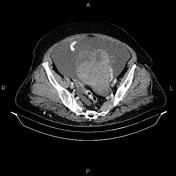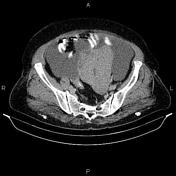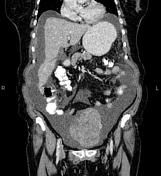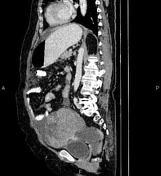Presentation
Abdominopelvic pain and progressive distention.
Patient Data









Massive abdominopelvic ascites is present accompanied by omental thickening and strands.
A (143 x 108 mm) cystic solid mass is present at left side of pelvis originated from the left ovary, without evidence of local invasion to adjacent pelvic structures.
A few subcentimeter simple cortical cysts are seen at kidneys.
Degenerative changes as osteophytosis are seen at the lumbar spine.
Lumbar scoliosis of left-sided convexity.
Case Discussion
Left ovarian complex cystic solid mass with massive ascites and omental thickening (peritoneal carcinomatosis), pathologically proven as ovarian serous cystadenocarcinoma.




 Unable to process the form. Check for errors and try again.
Unable to process the form. Check for errors and try again.